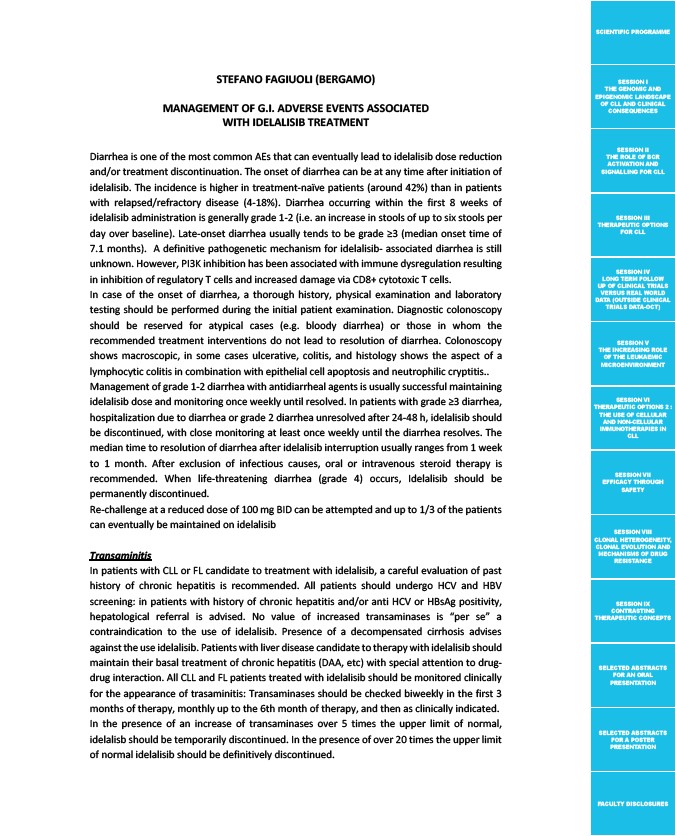
SCIENTIFIC PROGRAMME
SESSION I
THE GENOMIC AND
EPIGENOMIC LANDSCAPE
OF CLL AND CLINICAL
CONSEQUENCES
SESSION II
THE ROLE OF BCR
ACTIVATION AND
SIGNALLING FOR CLL
SESSION III
THERAPEUTIC OPTIONS
FOR CLL
SESSION IV
LONG TERM FOLLOW
UP OF CLINICAL TRIALS
VERSUS REAL WORLD
DATA (OUTSIDE CLINICAL
TRIALS DATA-OCT)
SESSION V
THE INCREASING ROLE
OF THE LEUKAEMIC
MICROENVIRONMENT
SESSION VI
THERAPEUTIC OPTIONS 2 :
THE USE OF CELLULAR
AND NON-CELLULAR
IMMUNOTHERAPIES IN
CLL
SESSION VII
EFFICACY THROUGH
SAFETY
SESSION VIII
CLONAL HETEROGENEITY,
CLONAL EVOLUTION AND
MECHANISMS OF DRUG
RESISTANCE
SESSION IX
CONTRASTING
THERAPEUTIC CONCEPTS
SELECTED ABSTRACTS
FOR AN ORAL
PRESENTATION
SELECTED ABSTRACTS
FOR A POSTER
PRESENTATION
FACULTY DISCLOSURES
STEFANO FAGIUOLI (BERGAMO)
MANAGEMENT OF G.I. ADVERSE EVENTS ASSOCIATED
WITH IDELALISIB TREATMENT
Diarrhea is one of the most common AEs that can eventually lead to idelalisib dose reduction
and/or treatment discontinuation. The onset of diarrhea can be at any time after initiation of
idelalisib. The incidence is higher in treatment-naïve patients (around 42%) than in patients
with relapsed/refractory disease (4-18%). Diarrhea occurring within the first 8 weeks of
idelalisib administration is generally grade 1-2 (i.e. an increase in stools of up to six stools per
day over baseline). Late-onset diarrhea usually tends to be grade ≥3 (median onset time of
7.1 months). A definitive pathogenetic mechanism for idelalisib- associated diarrhea is still
unknown. However, PI3K inhibition has been associated with immune dysregulation resulting
in inhibition of regulatory T cells and increased damage via CD8+ cytotoxic T cells.
In case of the onset of diarrhea, a thorough history, physical examination and laboratory
testing should be performed during the initial patient examination. Diagnostic colonoscopy
should be reserved for atypical cases (e.g. bloody diarrhea) or those in whom the
recommended treatment interventions do not lead to resolution of diarrhea. Colonoscopy
shows macroscopic, in some cases ulcerative, colitis, and histology shows the aspect of a
lymphocytic colitis in combination with epithelial cell apoptosis and neutrophilic cryptitis..
Management of grade 1-2 diarrhea with antidiarrheal agents is usually successful maintaining
idelalisib dose and monitoring once weekly until resolved. In patients with grade ≥3 diarrhea,
hospitalization due to diarrhea or grade 2 diarrhea unresolved after 24-48 h, idelalisib should
be discontinued, with close monitoring at least once weekly until the diarrhea resolves. The
median time to resolution of diarrhea after idelalisib interruption usually ranges from 1 week
to 1 month. After exclusion of infectious causes, oral or intravenous steroid therapy is
recommended. When life-threatening diarrhea (grade 4) occurs, Idelalisib should be
permanently discontinued.
Re-challenge at a reduced dose of 100 mg BID can be attempted and up to 1/3 of the patients
can eventually be maintained on idelalisib
Transaminitis
In patients with CLL or FL candidate to treatment with idelalisib, a careful evaluation of past
history of chronic hepatitis is recommended. All patients should undergo HCV and HBV
screening: in patients with history of chronic hepatitis and/or anti HCV or HBsAg positivity,
hepatological referral is advised. No value of increased transaminases is “per se” a
contraindication to the use of idelalisib. Presence of a decompensated cirrhosis advises
against the use idelalisib. Patients with liver disease candidate to therapy with idelalisib should
maintain their basal treatment of chronic hepatitis (DAA, etc) with special attention to drug-drug
interaction. All CLL and FL patients treated with idelalisib should be monitored clinically
for the appearance of trasaminitis: Transaminases should be checked biweekly in the first 3
months of therapy, monthly up to the 6th month of therapy, and then as clinically indicated.
In the presence of an increase of transaminases over 5 times the upper limit of normal,
idelalisb should be temporarily discontinued. In the presence of over 20 times the upper limit
of normal idelalisib should be definitively discontinued.